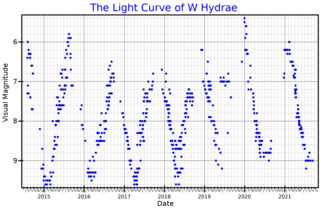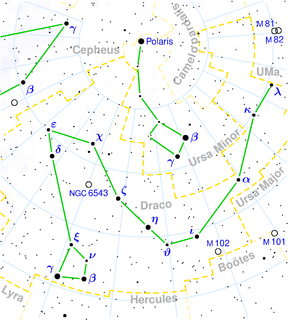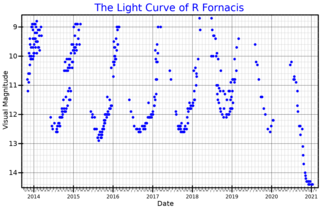
The descriptive term long-period variable star refers to various groups of cool luminous pulsating variable stars. It is frequently abbreviated to LPV.

Alpha Vulpeculae, officially named Anser, is the brightest star in the constellation of Vulpecula. It is approximately 291 light-years from Earth. It forms a wide optical binary with 8 Vulpeculae.
Lambda Ursae Minoris is a star in the constellation Ursa Minor. It is an M-type red giant with an apparent magnitude of +6.38 and is approximately 880 light years from Earth.
21 Cancri is a double star in the northern zodiac constellation of Cancer. It is just visible to the naked eye as a dim, red-hued star with an apparent visual magnitude of 6.08. The star is located around 820 light years away from the Sun, based on parallax. It is moving further from the Earth with a heliocentric radial velocity of 35 km/s.

119 Tauri is a red supergiant star in the constellation Taurus. It is a semiregular variable and its angular diameter has been measured at about 10 mas.

R Centauri is a Mira variable star in the constellation Centaurus. It is approximately 1,300 light years from Earth.

R Andromedae is a Mira-type variable star in the constellation Andromeda. Its spectral class is type S because it shows absorption bands of zirconium monoxide (ZrO) in its spectrum. It was among the stars found by Paul Merrill to show absorption lines of the unstable element technetium, establishing that nucleosynthesis must be occurring in stars. The SH molecule was found for the first time outside earth in the atmosphere of this star. The star is losing mass due to stellar winds at a rate of 1.09×10−6M☉/yr.
HD 36678 is single star in the northern constellation of Auriga. This star is dimly visible to the naked eye with an apparent visual magnitude of 5.83. It is located at a distance of approximately 840 light years from the Sun based on parallax. This is an aging red giant star with a stellar classification of M0III. It is currently on the asymptotic giant branch of the HR diagram, and has expanded to ~63 times the radius of the Sun. The star is radiating ~875 times the Sun's luminosity from its enlarged photosphere at an effective temperature of 3,950 K.
TX Camelopardalis is a Mira-type variable star in the constellation Camelopardalis. It is a classical long period variable star with pulsational period of 558.7 days. Water masers have been observed around the star.

W Hydrae is a Mira-type variable star in the constellation Hydra. The star is nearly located within the Solar neighborhood, between 75 and 120 parsecs, likely at 320 light years from the Sun. It has a visual apparent magnitude range of 5.6 to 10. In the near-infrared J band it has a magnitude of -1.7, is the 7th brightest star in the night sky, and is even brighter than Sirius.

RT Carinae, also known as CD-58 3538, is a variable star in the Carina Nebula in the constellation Carina. It has a mean apparent magnitude of +8.55.
106 Herculis is a variable star in the northern constellation Hercules. It is visible to the naked eye as a faint, red-hued point of light with a baseline apparent visual magnitude of 4.96. Based on its parallax, it is estimated to lie 383 light-years away from the Sun. The star is moving closer to the Earth with a heliocentric radial velocity of -35 km/s.
Mu Muscae, Latinized from μ Muscae, is a solitary star in the southern constellation of Musca. It is visible to the naked eye as a faint, orange-hued star with an apparent visual magnitude of around 4.75. Based upon an annual parallax shift of 7.21 mas as seen from Earth, it is located about 450 light years from the Sun. The star is drifting further away with a radial velocity of +37 km/s.
η2 Pictoris, Latinised as Eta2 Pictoris, is a solitary star in the southern constellation of Pictor. It is visible to the naked eye as a dim, orange-hued star with an apparent visual magnitude of 5.02. With an annual parallax shift of 7.8 mas as seen from the Earth, it is located around 418 light years from the Sun. It is a member of the HR 1614 moving group of stars that share a common motion through space.

EV Carinae is a red supergiant and pulsating variable star of spectral type M4Ia in the constellation Carina. It is a semiregular variable star with its apparent magnitude varying between 7.4 and 9.0 in the visible band, making it only seen by binoculars or a telescope. Various periods have been identified, but the dominant one is around 347 days. It is an MK spectral standard star for the class M4.5Ia.
CK Carinae is a variable star in the constellation Carina, the keel of Argo Navis. It is a member of the star association Carina OB1-D, at a distance of around 2,300 parsecs or 7,500 light years.

V528 Carinae is a variable star in the constellation Carina.

BO Carinae, also known as HD 93420, is an irregular variable star in the constellation Carina.

64 Draconis is a single star in the northern circumpolar constellation of Draco, located 452 light years away. It has the Bayer designation of e Draconis; 64 Draconis is the Flamsteed designation. The object is visible to the naked eye as a dim, red-hued star with an apparent visual magnitude of 5.27. It is moving closer to the Earth with a heliocentric radial velocity of −36 km/s, and it is predicted to come as close as 204 ly in around 4.3 million years.

R Fornacis is a Mira variable and carbon star located in the constellation Fornax. It is around 1,800 light years away based on parallax measurements.











